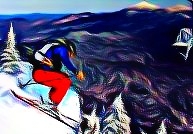Confidence Increasing on High Elevation Snowfall Later This Week
Before you get too excited, let me state that a best case scenario out of this is a couple inches of wet snow above 3,000ft but I do think later this week the lofty ridges of the Greens, Adirondacks, and Whites will be coated in white. Dare I say it might even be enough for some low angle junk board skiing/riding on things like the upper reaches of the Toll/Auto Roads on Whiteface, Mansfield, and Washington?
Our first strong autumn storm will deepen on Monday and Monday night over the northern Great Lakes region as the mid and upper level lows cut off and become vertically stacked just north of Lake Ontario. Once the upper levels become cut-off from the main flow, the surface low will slow considerably and on Tuesday and Wednesday it just drifts northeast up the St Lawrence River Valley into northeastern Quebec. There will be some synoptic precipitation associated with this storm on Tue/Wed as it passes north of the border but that precipitation will be in the form of rain.
As the vertically stacked system moves off to our northeast in Quebec, winds at all levels of the atmosphere swing around to the northwest later on Wednesday. This is very important because the precipitation will transition from synoptic to mesoscale in nature, focused heavily on the upslope regions of the northern Adirondacks and northern Greens. As this is happening, the deep layer NW flow will drill cold air from Canada into the Northeast. H85 (850mb or ~5,000ft) temperatures on both the European and GFS models drop to between 0C and -4C on Wednesday night and Thursday amid the moist cyclonic flow. Since the system is cut-off from the main flow and is vertically stacked, we will have no problem wrapping moisture back into the northern mountains and as this moisture interacts with the cold air push out of Canada, snow levels should drop rapidly to between 3K-4K ft on Wednesday night then hold there through Thursday in the chilly northerly flow.
This will become primarily an upslope event on Wednesday night and Thursday and I feel the models are under-estimating the amount of precipitation that falls during this time frame. Relative humidity values remain high between the surface and the H7 level and wind speeds at H85 (near ridge top level) are forecast to be between 25-35kts out of the NNW during this time. This is marginal but higher than the 25kt threshold for upslope precipitation production. This should produce a decent cross barrier flow into the northern Adirondacks and northern Greens and as the maritime moisture (wrapping around stacked cut-off low to our NE) is forced into the topography, we have a significant mechanism for precipitation production. Couple that with the cold air being drilled in from Canada and we have high elevation snow baby!
Now, seeing as this is still 5 days away there are a lot of details to be worked out. The situation is extremely marginal and the amount of cold air we get in here, as well as the placement of the low to our NE, will dictate the amount of precipitation that could fall as snow. The models are in decent agreement with the overall situation but there’s a big difference between H85 temps of 0C (slushy coating possible at 4,000ft+) and H85 temps of -3C (a couple wet inches possible down to 3,000ft). Also, if the low pressure tracks further north and east than progged, it will reduce the amount of upslope that occurs when the cold air is in place as we’ll have a weaker wind flow and be further removed from the moist cyclonic flow.
Bottom line: Stay tuned.
2 Comments
Leave a Reply
|
|||
| Home |






Lionel Hutz
wrote on September 27th, 2009 at 10:04 pmGreat write up Scott.
For our weather fans out there could you explain the effect of “vertically stacked low” v. a “negatively tilted low”
Greg
wrote on September 28th, 2009 at 9:18 amsweeeeeeetttttt!!! (famous internet) silly skiing is nearly here!